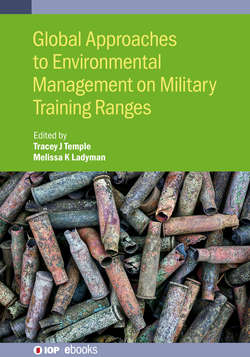Читать книгу Global Approaches to Environmental Management on Military Training Ranges - Tracey Temple - Страница 25
На сайте Литреса книга снята с продажи.
1.4.2 Computational modelling
ОглавлениеThe most important parameter in explosives’ environmental fate and transport studies is the contaminant concentration (C), which corresponds to the amount of that substance in a specific volume or mass of air, water, soil, or other material.
Many processes affect the fate, transport and transformation of a particular contaminant in the subsurface. The overall composition of leachates produced reflects the degree of aerobic and anaerobic decomposition as well as retention within the soil matrix. Understanding how this material can become mobilised and what happens to it is difficult and complex as the contaminant transport subsurface is affected by a large number of nonlinear and often interactive physical, chemical and biological processes (section 1.3) [106, 107]. Such processes can be modelled by mathematical equations, which describe the dependence of unknown quantities of interest (e.g. TNT concentration at some point and time) on known or estimable parameters (e.g. permeability, reaction coefficients, mass loading). The models are developed from conceptual models derived from laboratory and/or field observations of parameters to be interrelated. Concentration is a key quantity in fate and transport equations as a substance’s concentration in an environmental medium also determines the magnitude of its biological effect. Because of the complexity of processes, simplifying assumptions can be introduced to make the model more tractable numerically, i.e. neglecting processes considered to be of minor influence such as volatility.
The most common conceptual models in the literature are based on the assumption that solid explosive residues (ER) in soils are dissolved by infiltrating precipitation at or near the ground surface and subsequently leached through the subsurface as a dissolved phase [107, 108].
The main transport processes occurring into the subsurface are advection, dispersion and diffusion in the liquid and gaseous phases that lead to solute transport and sorption [109]; therefore advective-dispersive-reactive transport (ADRT) is the underlying process governing the migration of explosives though a porous medium [4, 109], which can be written as (1.1)
where c = concentration, [M/L3]; t = time, [T]; n = effective porosity; D = hydrodynamic dispersion, [L2/T]; z = coordinate system, [L]; = average linear velocity, [L/T]; Rf = reactive term.
The ADRT equation describes the time-varying change in concentration of reactive dissolved contaminants in saturated, homogeneous, isotropic material under steady-state and uniform flow conditions. The term nD∂2c∂z2 represents dispersive transport and nv∂c∂z corresponds to advective transport. The concentration can change if there is a different concentration elsewhere in the flowing fluid and this different concentration is carried by advection to the fixed point of interest. The concentration can also change by Fickian transport if there is a spatially varying concentration gradient in the fluid due to the dispersion. Changes in the concentration also can occur if a source or sink process, such as a chemical or biological reaction, is introducing or removing the compound of interest (Rf).
Additional physical processes in the subsurface may include capillary and gravitational forces that cause transient water flow, dissolution, volatilisation, biotransformation, abiotic reaction, and convection and conduction that result in heat transport [110]. The mechanisms of the main processes mentioned are described in the following.
